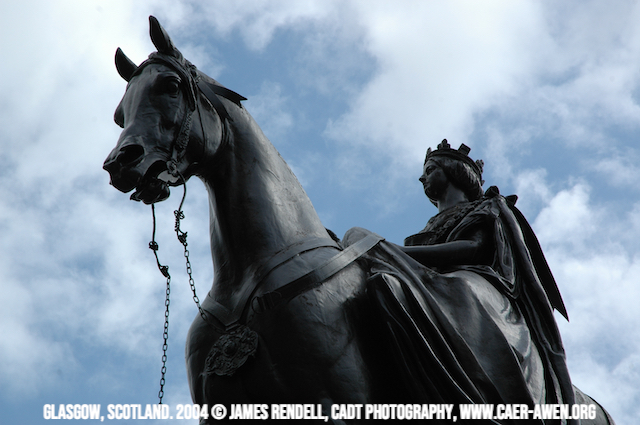These photographs are from Glasgow with a focus on the architecture of Charles Rennie Mackintosh in 2004.
Charles Rennie Mackintosh's architecture is considered by modern historians to be influential in the Art Nouveau movements, though there is a school of thought that describes these buildings as Old World because they were constructed before the modern era.
Glasgow is a great city to visit. It is very different from the Scottish Capital, Edinburgh which has a bigger English influence. Glasgow is influenced by the Highlands of the East Coast, so the accent is different and the residents are very clear that they are not English!
The Gallery, Above, contains a selection of curated camera proofs for narrative context and your viewing pleasure.
Charles Rennie Mackintosh (7 June 1868 – 10 December 1928) was a Scottish architect, designer, water colourist and artist. His artistic approach had much in common with European Symbolism. His work, alongside that of his wife Margaret Macdonald, was influential on European design movements such as Art Nouveau and Secessionism and praised by great modernists such as Josef Hoffmann. Mackintosh was born in Glasgow, Scotland and died in London, England. He is among the most important figures of Modern Style (British Art Nouveau style).
Mackintosh lived most of his life in the city of Glasgow, located on the banks of the River Clyde. During the Industrial Revolution the city had one of the greatest production centres of heavy engineering and shipbuilding in the world. As the city grew and prospered, a faster response to the high demand for consumer goods and arts was necessary. Industrialized, mass-produced items started to gain popularity. Along with the Industrial Revolution, Asian style and emerging modernist ideas also influenced Mackintosh's designs. When the Japanese isolationist regime softened, they opened themselves to globalisation resulting in notable Japanese influence around the world. Glasgow's link with the eastern country became particularly close with shipyards at the River Clyde being exposed to Japanese navy and training engineers. Japanese design became more accessible and gained great popularity. In fact, it became so popular and so incessantly appropriated and reproduced by Western artists, that the Western world's fascination and preoccupation with Japanese art gave rise to the new term Japonisme or Japonism.
This style was admired by Mackintosh because of its restraint and economy of means rather than ostentatious accumulation; its simple forms and natural materials rather than elaboration and artifice; and its use of texture and light and shadow rather than pattern and ornament. In the old western style, furniture was seen as ornament that displayed the wealth of its owner; the value of the piece was established according to the length of time spent creating it. In the Japanese arts, furniture and design focused on the quality of the space, which was meant to evoke a calming and organic feeling to the interior.
At the same time a new philosophy concerned with creating functional and practical design was emerging throughout Europe: modernism. The central aim in modernism was to develop a purity of expression with designs explicitly responsive to intended building use. Ornament and traditional styles were demoted. Although Mackintosh has been counted as a pioneer of modernism, his work always retained a decorative sensibility and features ornament. Mackintosh took his inspiration from his Scottish upbringing and blended them with the flourish of Art Nouveau and the simplicity of Japanese forms.
While working in architecture, Charles Rennie Mackintosh developed his own style: a contrast between strong right angles and floral-inspired decorative motifs with subtle curves (for example, the Mackintosh Rose motif), along with some references to traditional Scottish architecture. The project that helped make his international reputation was the Glasgow School of Art (1897–1909). During the early stages of the Glasgow School of Art Mackintosh also completed the Queen's Cross Church project in Maryhill, Glasgow. It is the only built Mackintosh church design and is now the Charles Rennie Mackintosh Society headquarters. As with his contemporary Frank Lloyd Wright, Mackintosh's architectural designs often included extensive specifications for the detailing, decoration, and furnishing of his buildings.
The majority, if not all, of this detailing and significant contributions to his architectural drawings were designed and detailed by his wife Margaret Macdonald whom Charles had met when they both attended the Glasgow School of Art. Their work was shown at the eighth Vienna Secession Exhibition in 1900. Mackintosh's architectural career was a relatively short one, but of significant quality and impact. All his major commissions were between 1895 and 1906, including designs for private homes, commercial buildings, interior renovations and churches.
Interior designs for his brother-in-law, Charles Macdonald at Dunglass
Hill House, Helensburgh This dwelling is one of the last complete sites, that is filled with furnishing and fittings, designed by Mackintosh in Scotland. Mackintosh paid attention to detail with every aspect of this property.
The Willow Tearooms, Sauchiehall Street, Glasgow for Catherine Cranston
Former Daily Record offices, Glasgow
Former Glasgow Herald offices in Mitchell Street, now The Lighthouse – Scotland's Centre for Design and Architecture
78 Derngate, Northampton (interior design and architectural remodelling for Wenman Joseph Bassett-Lowke, founder of Bassett-Lowke)
5 The Drive, Northampton (for Bassett-Lowke's brother-in-law)
From: Wikipedia
Keep Smiling and Thank you for your Visit! Please Buy us a Coffee to Support our Community Work or Contact Us to Arrange to purchase a Print Sized Image or a signed limited edition print.












